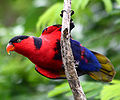Black-capped lory
| Black-capped lory | |
|---|---|

| |
| At Jurong BirdPark, Singapore | |
| Scientific classification | |
| Domain: | Eukaryota |
| Kingdom: | Animalia |
| Phylum: | Chordata |
| Class: | Aves |
| Order: | Psittaciformes |
| Family: | Psittaculidae |
| Genus: | Lorius |
| Species: | L. lory
|
| Binomial name | |
| Lorius lory | |
| Synonyms | |
|
Psittacus lory Linnaeus, 1758 | |
The black-capped lory (Lorius lory) also known as western black-capped lory or the tricolored lory, is a parrot found in New Guinea and adjacent smaller islands. It is a colourful and relatively robust lory (31 cm). There are seven subspecies, all with green wings, red heads and body around the wing, a black cap, grey-black cere, yellow underwings, and blue legs and belly. Most also have a blue nape and mantle (area between wings on the back). It remains overall widespread and common, but the subspecies cyanuchen is relatively rare, with fewer than 5000 individuals remaining.
Subspecies

The subspecies vary considerably in colour:
- L. l. lory: West Papuan islands and Bird's Head Peninsula. Blue of nape, mantle, and belly merge to cover most of body and are purple-blue. Red underwing coverts. Juvenile resembles erythrothorax or cyanuchen.
- L. l. erythrothorax: The whole south coast of New Guinea east of Bird's Head Peninsula, and the SE north coast. Blue nape almost forms collar, blue comes halfway up belly. Yellow on wings. Blue mantle in two bands. Red underwing coverts.
- L. l. somu: Southern hill districts of central New Guinea. Red mantle and nape, blue only low on belly.
- L. l. salvadorii: Northwest coast of Papua New Guinea. Like erythrothorax but with blue-black underwing coverts.
- L. l. viridicrissalis: Northeast coast of Western New Guinea. Like salvadorii but blue blacker everywhere.
- L. l. jobiensis: Yapen and Mios Num islands. Like salvadorii but paler breast and mantle bands.
- L. l. cyanuchen: Biak island. Black of cap meets blue of nape, single blue mantle stripe.
Behavior
Their black-capped lory inhabits the primary forest and forest edges in most lowland areas up to 1000m (sporadically to 1750m), but not monsoon forest or coconut plantations. It is usually found in pairs and occasionally in groups of 10 or more. Their diet includes pollen, nectar, flowers, fruit and insects.
Gallery
-
Upper body
-
At Jurong BirdPark, Singapore
-
Drinking nectar at Jurong BirdPark
-
Wing plumage - at Jurong BirdPark
References
- ^ BirdLife International (2012). "Lorius lory". IUCN Red List of Threatened Species. 2012. Retrieved 26 November 2013.
{{cite journal}}: Invalid|ref=harv(help)
- Parrots: A Guide to Parrots of the World; 1998, ISBN 0-300-07453-0.







